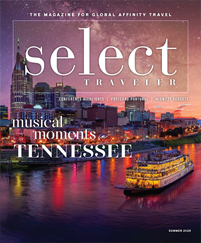Few things in life can evoke stronger emotion than music: the way a guitar refrain sounds like a conversation or how lyrics speak to your life or when a drumbeat forces you to dance. Travel Alliance Partners showcase the best of music, and TAP itineraries immerse travelers in country and Cajun, blues and bluegrass.
Grand Ole Opry
Nashville, Tennessee
The radio show that was the forerunner of today’s Grand Ole Opry began in 1925, and the Opry has had several homes throughout the decades before finally settling at its current venue in 1974.
“For many years, we never allowed anyone behind that big red curtain,” said Wayne Chandler, director of sales for the Grand Ole Opry Entertainment Group. “Luckily, the decision was made to let people journey in the footsteps of the artists at the Opry House as well.”
Visitors have three tour options. Daytime tours include backstage access, and postshow tours allow guests to watch a show, then tour backstage immediately afterward. The day tours are bit more leisurely, and the postshow tours are good and lively. VIP tours allow visitors backstage during the weekly stage concert/radio show, but they’re limited to 20 people, so they’re generally not good for groups, Chandler said.
“Postshow, our techs and stagehands and sometimes the artists are still there, which brings a different excitement to the tour,” he said.
Both daytime and postshow tours allow visitors to see the artists’ entrance and pass by the artists’ post office, where they still pick up fan mail and requests; tour 18 themed dressing rooms; and check out memorabilia from the Opry’s storied history, including Minnie Pearl’s size 10 shoes and the yo-yo President Nixon used when he got an unplanned onstage lesson from Roy Acuff.
Visitors can also step onto the Opry’s stage and into the six-foot circle of wood that was brought from the Ryman Auditorium and inlaid on the Grand Ole Opry stage in 1974.
“You can actually stand where Elvis Presley, Patsy Cline, Hank Williams Sr., Johnny Cash, George Jones have all stood,” Chandler said. “It’s a pretty moving experience.”
The live radio show will celebrate its 90th anniversary next year, and the venue is already planning a big party on October 3. The Opry — including backstage — will be open for self-guided tours, and the plaza will be filled with live music and food vendors.
Martin Accordions
Scott, Louisiana
The foot-stomping music of New Orleans often has a distinctive sound to it, one that may be difficult to place for those who aren’t familiar with it. The sound is an accordion, and the accordion is likely a Martin.
Martin Accordions has been making Cajun accordions for more than 30 years, but nothing makes an accordion Cajun other than “the type of music you play on it,” owner Clarence “Junior” Martin said in his thick Cajun drawl.
“A few people call them squeezeboxes — we call them Cajun accordions — but they’re really melodeons,” said Martin.
Melodeons, or diatonic button accordions, have buttons rather than keys like those found on a piano, and Martin has been making them for more than 30 years.
Martin Accordions is a family-run business that’s housed in a large warehouse in Scott, Louisiana, just outside Lafayette. One side of the building, which can seat up to 112 people, is a woodworking shop where workers make about 100 accordions a year, and the other side is the retail and repair business. When groups visit, Martin; his daughter, Pennye Huval; and his grandson, Joel Martin, give a 1.5-hour presentation. Everyone thinks that sounds boring, and everyone is always surprised, Huval said.
Although the family talks about the history of the accordion and the music traditionally played on it, which includes German polkas, they also demonstrate the music as they work their way through time, turning the presentation into a live concert complete with Cajun and zydeco music, as well as a gospel song that they sing half in English and half in French.
“It’s history, it’s culture, it’s music, it’s language and how it relates to the accordion,” Huval said. “They all leave here with the same expression: ‘This is not at all what I expected.’”









